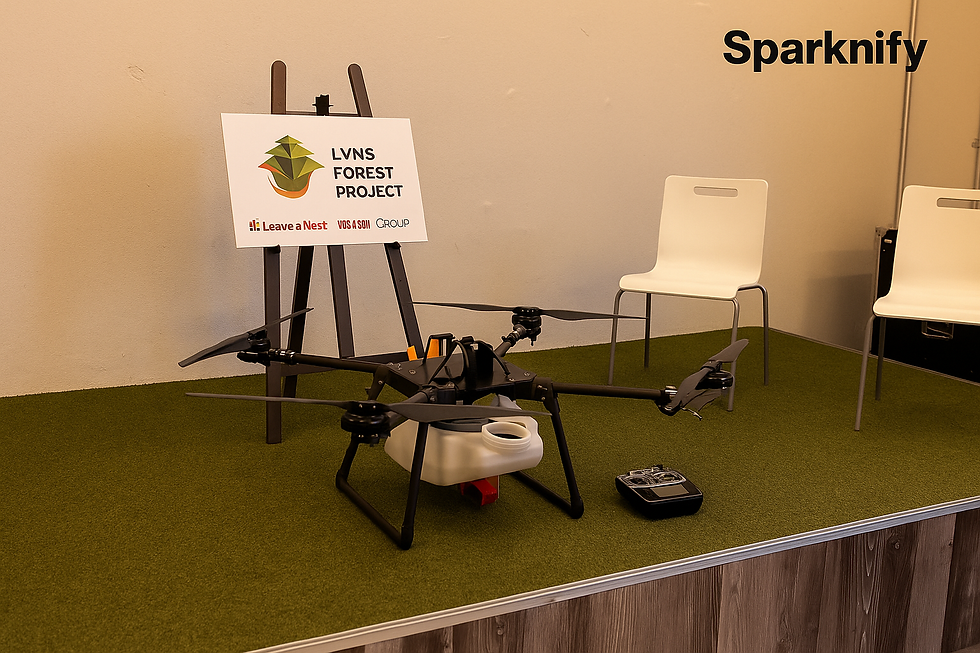AI Drones Reforesting Future
- Sparknify

- Jun 6
- 3 min read
Updated: Jul 5
Japan is pioneering a groundbreaking use of AI powered drones to dramatically accelerate reforestation, enabling forests to be planted up to 10 times faster than conventional manual methods. Developed by innovative engineers in Kyoto, these autonomous drones utilize cutting-edge artificial intelligence and LiDAR (Light Detection and Ranging) technologies to accurately scan and analyze fire damaged or deforested regions. This advanced system assesses critical environmental factors such as soil composition, moisture levels, terrain contours, and even potential risks like erosion or flooding.

Once data is collected, drones deploy biodegradable seed pods specifically designed to maximize growth potential. Each pod contains a carefully curated mix of native seeds, essential nutrients, and beneficial fungi that promote healthy plant development. These drones can carry more than 300 pods each, efficiently planting an area roughly the size of a football field within an hour. Operating in synchronized swarms and recharging through strategically placed solar stations, these drones dynamically adapt in real-time to evolving terrain and weather conditions.
Initial trials in wildfire-ravaged regions like Kumamoto have been highly promising, boasting germination rates exceeding 80%. This not only accelerates ecosystem recovery but significantly enhances the resilience of landscapes facing climate-driven disasters.

However, Japan is not alone in harnessing drone technology for reforestation. Companies like DroneSeed in the United States have deployed similar AI-guided drones to restore forests affected by wildfires. Unlike Japan’s approach, DroneSeed utilizes heavier payloads and focuses specifically on difficult terrains often inaccessible by human efforts, employing custom-designed seed vessels containing seedlings rather than just seeds.
Meanwhile, BioCarbon Engineering, based in the United Kingdom, is another prominent player in this space. Their drones conduct detailed aerial surveys before deploying seeds, prioritizing precision placement and post-planting monitoring through additional drone flights, integrating deeper machine learning capabilities to optimize ecological restoration continuously.
Academia wise, Dr. Iryna Dronova, Associate Professor in the Department of Landscape Architecture & Environmental Planning at the University of California, Berkeley, is a leading researcher at the intersection of ecology and geospatial technology. Her work bridges traditional field-based ecological methods with advanced tools like remote sensing, GIS, and UAV mapping to analyze the structure and function of vulnerable ecosystems at multiple spatial and temporal scales. Focused on wetland and urban environments, Dr. Dronova develops innovative monitoring frameworks for tracking landscape changes, assessing restoration outcomes, and detecting invasive species. Her integrative approach offers critical insights for managing ecosystems under pressure from climate change, urbanization, and environmental degradation—placing her at the forefront of drone-assisted ecological restoration research.

This intersection between human ingenuity and machine precision resonates deeply with Sparknify’s Human vs. AI initiative. Sparknify challenges us to consider how we maintain balance and ensure ethical stewardship in an increasingly autonomous technological landscape. When AI-driven drones not only augment but surpass human capability in tasks traditionally viewed as human-centered, critical questions emerge: What roles should humans retain, and how can we leverage AI to enhance rather than supplant human engagement?
Looking forward, the future possibilities are profound and expansive. Imagine an integrated network of AI-powered ecological drones working globally to restore biodiversity, rehabilitate coral reefs, or even reverse desertification. Additionally, AI could coordinate these efforts, optimizing resource allocation, ecological monitoring, and sustainability planning across international boundaries.
As this future unfolds, it’s crucial to maintain human oversight and ethical guidelines to ensure these powerful tools enhance our natural environment without eroding our humanity. Sparknify envisions a future where AI and human collaboration not only restores ecosystems but enriches our collective understanding of our role within the natural world.

![When Robots Pave the Road: The New Era of Infrastructure [Video]](https://static.wixstatic.com/media/21dd43_25626ec299f4426cb9fd5cd2c9aec607~mv2.jpg/v1/fill/w_980,h_735,al_c,q_85,usm_0.66_1.00_0.01,enc_avif,quality_auto/21dd43_25626ec299f4426cb9fd5cd2c9aec607~mv2.jpg)











Comments